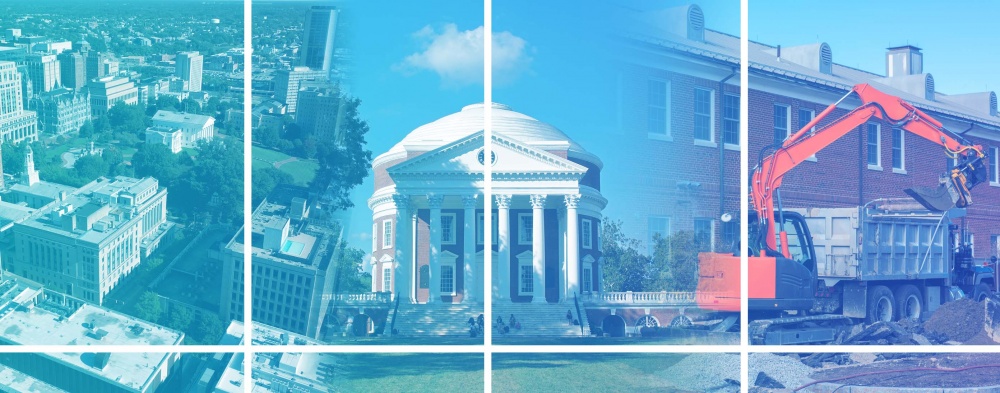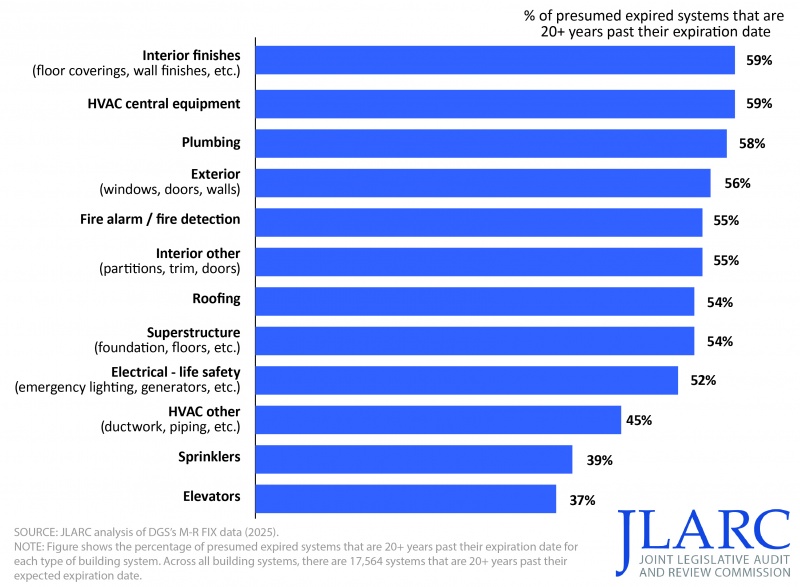Capital Maintenance and Construction

WHY WE DID THIS STUDY
In 2024, the Joint Legislative Audit and Review Commission directed staff to review Virginia’s approach to planning, maintaining, and funding capital assets at state agencies and public higher education institutions (HEIs), including data on building condition and use, and to evaluate project timeliness and ways to improve it.
ABOUT VIRGINIA'S CAPITAL ASSETS
Capital assets can include state-owned buildings, land, leases, infrastructure (e.g., sewer treatment, domestic water distribution), equipment (e.g., machinery, vehicles), and certain intangibles (e.g., software, patents, land use rights). JLARC staff focused on state-owned buildings and the systems within them (e.g., HVAC, plumbing, electrical, etc.) for this study. This report focuses on agencies/HEIs that are responsible for managing their own buildings and are subject to the state’s traditional capital-related policies and processes. Some common building types are dormitories, corrections facilities, storage warehouses, multipurpose buildings, and office buildings. Together, the state-owned buildings within the scope of this study are currently valued between $31 billion and $47 billion, according to DGS and Department of Treasury data.
WHAT WE FOUND
Many state buildings and systems are old and have been in operation longer than their expected lifespans
The General Assembly, the governor, and agency leaders and staff have taken steps to improve the management of state-owned buildings over time. They have developed IT systems to record and track various data on state-owned buildings and capital projects and funded and managed the replacement of badly deteriorated facilities. Furthermore, the General Assembly has increased the amount of funding appropriated to agencies and public higher education institutions to better maintain their buildings and avoid costly repairs or replacements. These efforts have required significant staff time and resources and substantially increased the state’s financial commitment.
The state’s central repository of data on state-owned buildings and systems is a database of agency-reported data called “M-R FIX.” The Department of General Services (DGS) developed M-R FIX to allocate maintenance reserve funds, the state’s fund for eligible maintenance projects that cost between $25,000 and $2 million ($4 million for roofs). M-R FIX has incomplete and incorrect data, but it is at least sufficient to draw a few basic conclusions about the buildings that house state government and public higher education operations. M-R FIX data shows that about half of state-owned buildings are almost 50 years old or older, and about one-third of the systems (e.g., HVAC, roofing, plumbing, etc.) in state buildings are past their expected lifespans (i.e., expired), according to generic lifespan metrics. In addition, many building systems presumed to be expired are 20+ years past their expected lifespans (figure, next page).
M-R FIX does not include data on actual building condition, which limits visibility into state agencies’ and public higher education institutions’ (HEIs’) capital needs and priorities. Agencies/HEIs are not required, and do not receive funding, to assess and track the condition of their buildings. As a result, centralized information on the scope and urgency of maintenance needs of state-owned buildings is not available.
Many building systems presumed to be expired are 20+ years past their expected expiration dates

Given the apparent age of state buildings and their systems, capital planning could receive more attention
Multiple national industry groups and subject matter experts emphasize the importance of having a state- or agency-level capital improvement plan. Capital improvement plans can be difficult for state governments and individual agencies/HEIs to create and maintain in practice. This has been the case in Virginia, as well as other states. However, capital improvement plans—especially at the agency level—are a useful tool for identifying and documenting future capital projects needed. They are also useful for elected officials and their staff to make decisions about project funding. However, some agencies do not have one, including several with large capital needs (e.g., high square footage, significant maintenance needs).
Deferring needed maintenance will cost the state more over time
Delaying needed facility maintenance escalates the eventual cost of repairs or replacements. Projects may not be addressed immediately for several reasons, such as insufficient funding, insufficient staffing, poor planning, or decisions by agency/HEI leaders. Cost escalation occurs because prices for the materials and labor needed to complete maintenance projects rise over time. The cost of maintenance services has increased 51 percent over the past decade, according to building cost index data.
Eventually, a facility’s poor condition will need to be addressed, such as when a critical system like an HVAC unit fails. Deferring ongoing maintenance needs until problems occur often leads to expensive and avoidable repairs. Systems pushed to the point of failure may require a costly replacement rather than a simpler repair.
Building maintenance needs far exceed available state funding, and maintenance funds could be better allocated among agencies/HEIs
State agencies and HEIs often receive funding—usually general funds, but sometimes state-issued debt—to pay for their buildings’ major maintenance needs. These “maintenance reserve” funds are designated for projects that are too large to address using operating funds, but too small to require capital outlay project funding. Although state funding for maintenance projects has generally increased over time, it remains significantly below what is needed to cover existing maintenance needs.
The state does not currently have an estimate for the total cost of addressing needed maintenance at state-owned buildings. However, data collected by JLARC staff from 12 agencies/HEIs with the majority of state-owned building square footage indicates that current maintenance reserve project needs exceed $1.1 billion. Moreover, nearly two-thirds of agencies/HEIs responding to an information request said they did not receive enough maintenance reserve funding in FY24 for essential maintenance projects.
Virginia’s approach to allocating state funds appropriated for maintenance reserve projects across agencies/HEIs needs improvement. The allocation of agencies’/HEIs’ “shares” of state maintenance reserve funding is primarily based on the number of systems in their buildings that are presumed to have reached their expected lifespans (i.e., they have expired) and not the actual condition of agencies’/HEIs’ buildings/systems or maintenance needs. For example, the calculation does not account for a building/system that has major maintenance needs before its presumed expiration date, which could result in an agency/HEI receiving a smaller allocation than it should receive. The methodology also does not account for systems that are presumed to be expired but are still in good condition, which could result in an agency/HEI receiving shares (and therefore funding) that would more properly be allocated to other agencies/HEIs.
Another concern is that DGS uses generic lifespans to determine whether agencies’/HEIs’ systems are expired. These generic lifespans do not account for important system differences. DGS uses the same expected lifespan (20 years) for all roofs, for example, even though roofs can have a lifespan of 20 to 75+ years depending on the type of roof (i.e., hipped, gabled, flat), the materials used (i.e., metal, slate, rubber membrane), or the builder/manufacturer. This approach is imprecise and can result in agencies/HEIs receiving “shares” for systems that are still in good condition and do not require maintenance or not receiving shares for systems that need maintenance but are not presumed to be expired.
Allocations of state maintenance reserve appropriations also do not properly account for buildings that are not being used. Buildings that are identified as “underutilized” or “surplus,” including several buildings that are associated with facilities that have closed, are included in agencies’/HEIs’ square footage, and therefore affect these agencies’/HEIs’ maintenance reserve allocations.
Completing some state capital outlay projects takes longer than 10 years, and many projects take longer than expected
Capital outlay projects are major projects that are individually authorized through the budget process. Capital outlay projects may involve new construction, maintenance (e.g., major renovation of an existing building or infrastructure repair), equipment purchases, demolition, or acquisition of property. Capital outlay projects for new construction typically cost $3 million or more or are 5,000 or more square feet. Capital outlay projects for maintenance typically cost $3 million or more. As of spring 2025, 525 state government capital outlay projects were “open.”
While Virginia lacks comprehensive data on the status of capital outlay projects, JLARC staff were able to determine that nearly two-thirds (65 percent) of projects “completed” since FY21 have taken longer to finish than a typical benchmark of five years. Five years is a reasonable expectation for the lifespan of a large capital project, according to several other states and Virginia localities, though some projects that are particularly large or complex may take longer. Almost a quarter of projects (22 percent) took more than 10 years to complete.
Key information about capital outlay projects’ progress is not consolidated centrally, which prevents central agencies as well as decisionmakers from proactively intervening to address problems that are causing delays. Periodically reviewing the status of capital outlay projects across state government would enable decisionmakers to identify delayed projects that need more attention or additional support. The faster a project is completed, the more likely it is to stay on budget, and the sooner it fulfills its purpose. This information could also help the governor and General Assembly make funding decisions.
Majority of capital outlay projects completed since FY21 exceeded five years to complete, and some exceeded a decade

Insufficient agency/HEI staff capacity and expertise contribute tocapital outlay project delays
National and Virginia subject matter experts emphasize the importance of agency/HEI staff having the knowledge and skills necessary to keep capital outlay projects on schedule and fulfilling their intended purpose. In Virginia, agencies/HEIs that own and maintain their buildings are typically also responsible for managing their own capital outlay projects. Agency/HEI staff have several key responsibilities, such as requesting state authorization and funding for capital outlay projects, ensuring contractors meet agency/HEI programmatic needs, and submitting various documents (e.g., design plans and funding requests) to DGS and DPB for review at particular milestones. Insufficient agency management of capital outlay projects can cause projects to take longer than needed.
Capital outlay projects have frequently been delayed because of mistakes the agency/HEI staff managing the project made when submitting required documents to DGS and DPB (e.g., design documents, funding requests). Common agency/HEI staff mistakes include submitting incomplete materials, resubmitting materials without addressing all issues, and skipping or not initiating steps in the process (e.g., capital budget requests for equipment). Such mistakes have delayed recent capital outlay projects and stem from inadequate knowledge of the state’s capital outlay process and policies and inadequate project management skills (e.g., strategic scheduling, anticipating project challenges, effective communication with contractors, etc.).
Some capital outlay projects are also delayed because agency/HEI staff change the project “scope,” or delay project initiation.
WHAT WE RECOMMEND
Legislative action
- Require agencies and public higher education institutions that have a large amount of square footage or older buildings to complete formal “facility condition assessments” (providing funding as needed for hiring or contracting with appropriate experts to perform these assessments), and direct DGS to establish assessment guidelines to ensure comparability.
- Require agencies and public higher education institutions whose state-owned buildings have a large footprint (i.e., square footage) or extensive maintenance needs to develop six-year capital improvement plans every two years that detail needed maintenance reserve and capital outlay projects, including estimated costs, project priority levels, and proposed funding timelines.
- Direct DGS to estimate the total cost of statewide capital maintenance reserve project needs and require the Six-Year Capital Outlay Plan Advisory Committee to set an annual goal for funding a set percentage of the cost.
- Direct DGS to establish the qualifications, trainings, and exams individuals need to complete to manage capital outlay projects and develop related trainings and exams.
- Direct the Six-Year Capital Outlay Plan Advisory Committee to establish criteria for potentially “significantly delayed” capital outlay projects and systematically review them.
Executive action
- DGS should develop expected building systems lifespan benchmarks that more precisely approximate when each system will be beyond its useful life.
- DGS should base its methodology for apportioning state maintenance reserve funding to agencies and public higher education institutions on the actual condition of state-owned buildings and systems once such information becomes available.
The full list of recommendations is available here.

